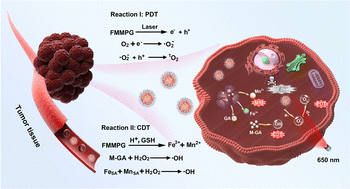Optimized silicate nanozymes with atomically incorporated iron and manganese for intratumoral coordination-enhanced once-for-all catalytic therapy†
Abstract
Although plant-derived cancer therapeutic products possess great promise in clinical translations, they still suffer from quick degradation and low targeting rates. Herein, based on the oxygen vacancy (OV)-immobilization strategy, an OV-enriched biodegradable silicate nanoplatform with atomically dispersed Fe/Mn active species and polyethylene glycol modification was innovated for loading gallic acid (GA) (noted as FMMPG) for intratumoral coordination-enhanced multicatalytic cancer therapy. The OV-enriched FMMPG nanozymes with a narrow band gap (1.74 eV) can be excited by a 650 nm laser to generate reactive oxygen species. Benefiting from the Mn–O bond in response to the tumor microenvironment (TME), the silicate skeleton in FMMPG collapses and completely degrades after 24 h. The degraded metal M (M = Fe, Mn) ions and released GA can in situ produce a stable M–GA nanocomplex at tumor sites. Importantly, the formed M–GA with strong reductive ability can transform H2O2 into the fatal hydroxyl radical, causing serious oxidative damage to the tumor. The released Fe3+ and Mn2+ can serve as enhanced contrast agents for magnetic resonance imaging, which can track the chemodynamic and photodynamic therapy processes. The work offers a reasonable strategy for a TME-responsive degradation and intratumoral coordination-enhanced multicatalytic therapy founded on bimetallic silicate nanozymes to achieve desirable tumor theranostic outcomes.



 Please wait while we load your content...
Please wait while we load your content...